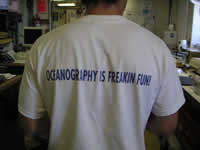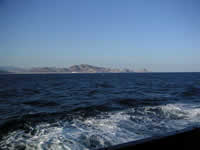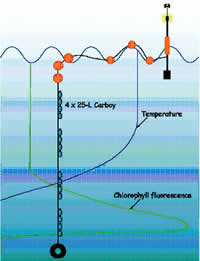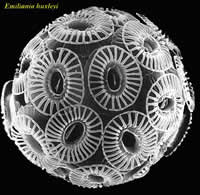


|
The Project Part 1: Part 2: Part 3:
|
09 August, 2005
|
 The array at the surface  Chris’s shirt  Cabo San Lucas, the tip of the Baja Peninsula |
More from The Log from the Sea of Cortez
At 3 a.m. Pacific time we passed the light on the false cape and made our new course northward, and the sky was gray and threatening and the wind increased. The Gulf was blotted out for us- the Gulf that was thought and work and sunshine and play. This new world of the Pacific took hold of us. We could not yet relate the microcosm of the Gulf with the macrocosm of the sea. As we went northward the gray waves rolled up and the Western Flyer stubbed her nose into them and the white spray flew over us.
This evening the R/V New Horizon rounded the tip of the Baja Peninsula, and we are headed HOME to San Diego. We’ll probably arrive there Friday evening; most of us are looking forward to getting there. The flying fish are still skimming across the waves, the sun is setting and the air and seawater are distinctly cooler on the Pacific side of the peninsula. We’re heading into a breeze, and the ship is going “uphill” towards California, so we may be cruising into some rougher water.
So how is the work of the scientists aboard the R/V New Horizon related to the biological pump and the greenhouse effect?
We know that the average temperature of the Earth has been rising steadily, and that carbon dioxide levels are at disturbingly high levels in the atmosphere today. During the Earth’s lifetime (about 4.5 billion years), there have been many changes in climate. Scientists are interested in the history of the earth’s climate. By understanding the climate in the past, they are better able to predict what the climate will be like in the future.
Many of the scientists onboard are studying alkenones. Alkenones are lipids (or fats) produced by only a couple of species of phytoplankton (mainly E. huxleyi or Ehux). Fred, the chief scientist on this cruise, does a lot of work studying how alkenones can be analyzed to measure past ocean temperatures. Richard’s work is an early step along the way to using alkenones to determine the level of carbon dioxide in the oceans, and by inference, in the atmosphere. Richard studies how quickly (or not) phytoplankton grow in different water temperatures and under different chemical conditions.
The amount of 13C (carbon thirteen) in the “old” alkenones buried in the seafloor is related to the amount of carbon dioxide that was in the water when Ehux were growing. In turn, the amount of carbon dioxide in the water is related to how much was in the air. Alkenones might be just the thing for relating past temperatures to carbon dioxide levels and figuring out how the greenhouse effect works!
When Ehux cells die, some of them sink and settle onto the seafloor, leaving alkenones buried in the sediment. Using Fred’s techniques, we can dig up the seafloor and tell how warm the water was going back through time (newer alkenones will be on top, and as you go deeper the alkenones get older). Since one of the suspected causes of global warming is the “greenhouse” effect caused by carbon dioxide in the air, it would also be useful to know how much carbon dioxide was in the air in the past. If we can get a record of both temperature and carbon dioxide levels, we will be better able to predict the effects of the alarmingly high levels of carbon dioxide in the air today.
 Now for the problem: the carbon dioxide level is not the ONLY thing controlling the amount of 13C in the “old” alkenones. It also depends on how FAST the phytoplankton were growing when the alkenones were made. Before scientists spend too much time trying to “decode” the alkenones on the seafloor, we had better figure out more specifically how the growth rate affects the amount of 13C in those alkenones. That’s why Richard puts the array with the carboys in the sea for 24 hours- to measure the growth rate of the phytoplankton.
Now for the problem: the carbon dioxide level is not the ONLY thing controlling the amount of 13C in the “old” alkenones. It also depends on how FAST the phytoplankton were growing when the alkenones were made. Before scientists spend too much time trying to “decode” the alkenones on the seafloor, we had better figure out more specifically how the growth rate affects the amount of 13C in those alkenones. That’s why Richard puts the array with the carboys in the sea for 24 hours- to measure the growth rate of the phytoplankton.
Math Problem:
Right now the R/V New Horizon is traveling at 11 knots per hour. The captain is predicting that we will arrive in San Diego at 3:00 pm Friday afternoon. Today is Wednesday, 10:00 am. How many miles away from San Diego are we? (Remember, you have to convert knots to land miles.)
Trivia Tidbit of the Day
The liver oil of certain species of sharks contains large amounts of vitamin A. Until the late 1940's, when scientists discovered an inexpensive way to manufacture vitamin A, shark liver oil ranked as a main source of this vitamin.
![]()

